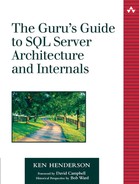How UMS Takes Over Scheduling
If UMS is to handle SQL Server's scheduling needs rather than allowing Windows to do so, UMS must somehow prevent the OS from doing what it does with every other process: schedule threads on and off the system's processor(s) as it sees fit. How do you do that in a preemptive OS? UMS pulls this off through some clever tricks with Windows event objects. Each thread under UMS has an associated event object. For purposes of scheduling, Windows ignores threads it does not consider viable—threads that cannot run because they are in an infinite wait state. Knowing this, UMS puts threads to sleep that it does not want to be scheduled by having them call WaitForSingleObject on their corresponding event object and passing INFINITE for the timeout value. As you'll recall from Chapter 3, when a thread calls WaitForSingleObject to wait on an object and passes INFINITE for the timeout value, the only way to awaken the thread is for the object to be signaled. When UMS wants a given thread to run, it signals the thread's corresponding event object. This allows the thread to come out of its wait state and permits Windows to schedule it to run on a processor.
In order to prevent Windows from scheduling multiple threads on the same processor and thereby incurring the overhead and expense of context switches, UMS attempts to keep just one thread viable—that is, not in an infinite wait state—per processor. There are exceptions to this (e.g., full-text queries, security validations, xproc invocations, linked server queries, and so on), but the system is designed to allow just one thread per processor to run at a time.
